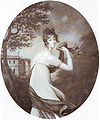- Dorothea von Medem
-
Dorothea von Medem Duchess of Courland Tenure 6 November 1779 - 28 March 1795
(15 years, 142 days)Spouse Peter von Biron Issue Princess Wilhelmine, Duchess of Sagan
Princess Pauline, Duchess of Sagan
Princess Johanna Katharina
Prince Peter
Princess DorotheaFather Friedrich von Medem Mother Louise Charlotte von Manteuffel Born 3 February 1761 Died 20 August 1821 (aged 60) Religion Lutheranism (Anna Charlotte) Dorothea von Medem (3 February 1761 – 20 August 1821) was born a Gräfin (Countess) of the noble German Baltic Medem family and later became Duchess of Courland (a Baltic region). Popularly known as Dorothea of Courland after her marriage to Peter von Biron, the last Duke of Courland, she hosted an aristocratic salon in Berlin and performed various diplomatic duties on behalf of her estranged husband.
Contents
Life
Anna Charlotte Dorothea was born at Mežotne Palace in Mežotne, now Latvia, to Friedrich von Medem, a Reichsgraf from the old Courland nobility and a general-poruchik of the Russian Empire, and his second wife, Louise Charlotte von Manteuffel. Her father, a descendant of Konrad von Mandern was himself awarded the Order of St. Alexander Nevsky in 1774 for his help in preparing the Treaty of Küçük Kaynarca. He owned many estates, including the Villa Medem in Jelgava. Her elder half sister from her father's previous marriage was the poet Elisa von der Recke.
On November 6, 1779, eighteen-year-old Dorothea became the third wife of the 37-year-old, childless Duke Peter von Biron, son of the famous Ernst Johann von Biron. The couple had six children, two of whom died in infancy. The four surviving children were all daughters; however, the youngest one, Dorothea, was probably illegitimate.
Dorothea was welcomed into the highest social circles thanks to her new status as duchess as well as her beauty. Because her husband was preoccupied with political difficulties at home involving his overlord the King of Poland and the Courland nobility, he frequently sent her on diplomatic missions to Warsaw, lasting months at a time, and to Berlin, Karlovy Vary, and Saint Petersburg for shorter periods. During these long absences Dorothea became alienated from her husband and had numerous love affairs with other men, including Gustaf Mauritz Armfelt, Talleyrand, and the Polish nobleman Alexander Batowski, who fathered her fourth daughter, born in 1793. After the year she gave birth to her illegitimate daughter, also named Dorothea (whom her husband nevertheless acknowledged as his own), the Duchess moved permanently to the Palais Kurland in Berlin, where she held an aristocratic salon.
In 1794 she acquired the Gutsherrschaft Löbichau in Altenburgischen and spent her summers at the newly-built Schloss there. Inviting poets, philosophers, relatives and friends to Löbichau, it became known as the Musenhof der Herzogin von Kurland. Her sister Elisa von der Recke, who would later be linked with Christoph August Tiedge, came to Löbichau to live and Tsar Alexander I of Russia, Frederick William III of Prussia, Napoleon I of France, Talleyrand, Metternich, Goethe, Schiller and other personalities of the time were the duchess's personal friends. In 1801, she received a proposal from Prince Frederick Adolf of Sweden.[1]
Upon her youngest daughter Dorothea's marriage to Talleyrand's nephew, Edmond de Talleyrand-Périgord, in 1809, the duchess moved to Paris, having an intense relationship with Talleyrand and influenced him to turn against Napoleon. In 1814 she traveled to the Congress of Vienna to confront him about his love affair with her daughter Dorothea. A few years after her death at Löbichau in 1821, the Duchess's body was moved from her place of death to the family vault at Sagan where her husband had been buried in 1800.
Issue
With Peter von Biron:
- Wilhelmine, Duchess of Sagan, mistress of Klemens Wenzel, Prince von Metternich
- Pauline, Duchess of Sagan and Hohenzollern-Hechingen
- Johanna Katharina, Duchess of Acerenza
- Peter, died aged three (February 23, 1787 – March 25, 1790)
- Charlotte, died aged three as well
With Alexander Batowski:
- Dorothea, protege (and alleged mistress) of Talleyrand and wife of his nephew the 2nd Duke of Talleyrand
Gallery
-
Her husband, Peter von Biron
-
Jelgava Palace, the Biron residence
Bibliography
- Elisa von der Recke: Tagebücher und Selbstzeugnisse. Leipzig 1984
- Emilie von Binzer: Drei Sommer in Löbichau 1819–21. Stuttgart 1877
- Philip Ziegler: Die Herzogin von Dino, Talleyrands letzte Vertraute. München 1965
- Clemens Brühl: Die Sagan. Berlin 1941
- Sabine und Klaus Hofmann: Zwischen Metternich und Talleyrand. Der Musenhof der Herzogin von Kurland im Schloss zu Löbichau. Museum Burg Posterstein, 2004
- Christoph August Tiedge: Anna Charlotte Dorothea. Letzte Herzogin von Kurland. F. A. Brockhaus, Leipzig 1823 Online-Version at Google Books
Notes
- ^ Cecilia af Klercker (1936) (in Swedish). Hedvig Elisabeth Charlottas dagbok VII 1800-1806 (The diaries of Hedvig Elizabeth Charlotte VIII 1800-1806). P.A. Norstedt & Söners förlag Stockholm. pp. 270–271. ISBN 362103.
External links
Categories:- 1761 births
- 1821 deaths
- Baltic-German people
- Baltic nobility
- Duchesses of Courland
- House of Biron
- People from Courland
- People from Mežotne
- Salon-holders
Wikimedia Foundation. 2010.










